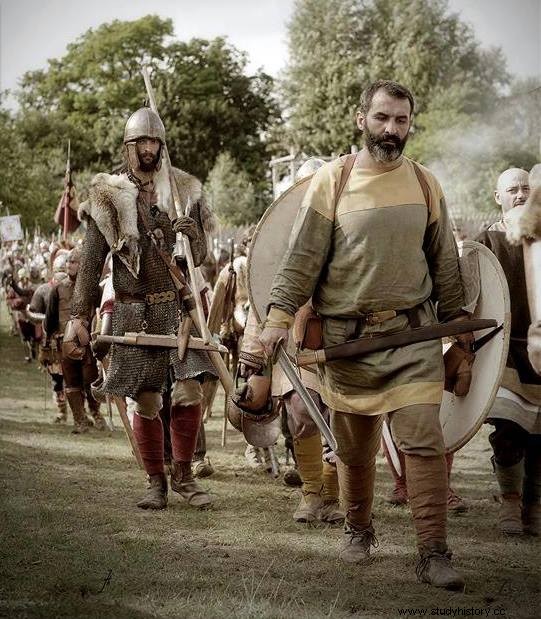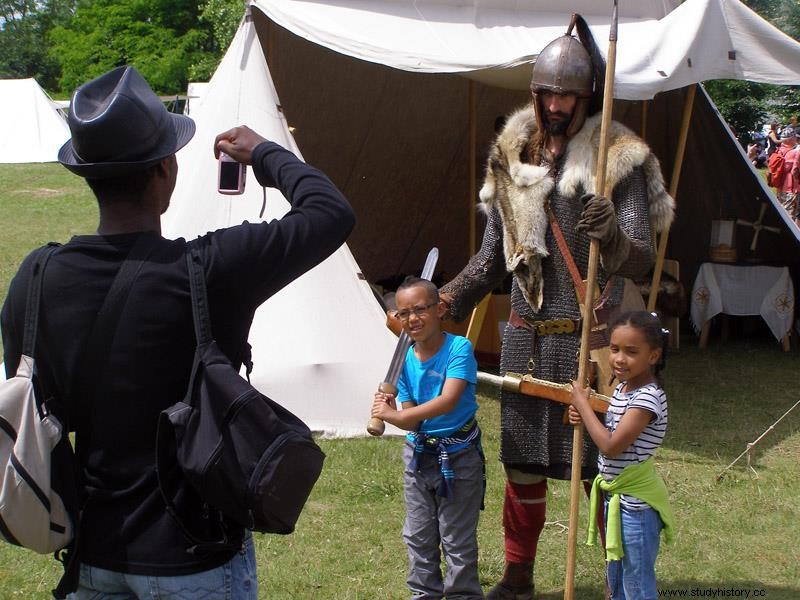
The most popular periods> reconstructed by historical re-enactment are still Rome (and its enemies or allies), the High Middle Ages, the Napoleonic Wars, and World War II. While in the United States the Civil War is the main protagonist, in Japan there is a special interest in the Edo period; although, in general, the chronological diversification is increasing.
When searching background historical references to this phenomenon, it is easy to fall into “presentism”. Some gladiatorial combats of ancient Rome and certain medieval tournaments tried to recreate, with weapons and clothing made on purpose, war events of the past. The interest in the Middle Ages typical of Romanticism meant that, already in the 19th century, these recreations began to be frequent, with a very unequal degree of rigour, something that coexisted with some military units that traditionally preserved ancient weapons and clothing.
However, the phenomenon of re-enactment modern emerges with collectors weapons and military that, on occasions, used authentic equipment and not replicas. From the sixties From the 20th century we can already speak of the existence of this phenomenon, centered on Modern and Contemporary times, from which groups interested in previous periods emerged. Thus, in 1972, two of the pioneering associations in the High Middle Ages and Roman times were born, The Vikings and the Ermine Street Guard , which popularized this hobby within the Anglo-Saxon sphere and from there it spread to other countries.
In Europe, the historical recreation of Antiquity (and to a lesser extent the Middle Ages) has shared objectives with experimental archaeology and has become a logical complement to the open air museums , archaeological classrooms and reconstructions of period towns. The interest shown by some researchers , like Marcus Junkelmann or Peter Connolly, towards this activity as a research tool has given recreation a certain prestige within the academic world, not so much in the Hispanic as in the European. The different hypotheses about the constructive system of the "four-horned" saddles, in charge of the two specialists mentioned, or that of the cheiroballistra described by the Pseudo –Heron developed by Aitor Iriarte, or the suggestive interpretations of the operation of the maniples by Dario Battaglia, have borne fruit in countless academic publications. In this way, the number 11 of the prestigious magazine The Journal of Roman Military Equipment Studies was dedicated to historical recreation, under the title Re-enactment as Research .

On the other hand, in the medieval historical reenactment, gained great importance combat simulations with black weapons (no edge or point), whether individual duels or skirmishes. Various sports fighting systems have been created , like the huscarl , with a series of rules and prohibited targets for the sake of safety. Some medieval and modern recreationists have opted for the European martial arts or Historical European Martial Arts (HEMA ), a martial activity that tries to reconstruct, thanks to a detailed study of the treatises of the time, fencing Europe in these periods. For this, reinforced fencing masks and "modern" protections are used, as well as weapons with special characteristics (without edges or points and with greater flexibility in the blade). There are those who, in short, practice both disciplines in parallel, although they are different phenomena, since the limitations on targets imposed by historical recreation and the prohibition of lunges mean that a large part of the technical repertoire cannot be used, although, on the other hand, collective training and the tactical dimension have gained importance.
Finally, in the modern field , Napoleonic and World War II, the quality and quantity of content continues to improve, within a markedly military approach. . On the bicentenary of the Battle of Waterloo , held this year, involved 5,000 re-enactors from all over Europe, with artillery and cavalry troops. In 1998 the largest recreation took place done to date, with 25,000 re-enactors at the Battle of Gettysburg . Although these figures do not reflect the real size of the belligerent armies, they allow us to contemplate something that, due to its dimensions, can well be considered a battle.
Historical re-enactment in Spain
In Spain, the origin of historical re-enactment is very old. The so-called “games of reeds” , equestrian competitions of the Renaissance that faced two teams, often had a historicist setting. In Levante and Andalusia there is a long tradition of festivals “Moors and Christians” , at least since the 16th century, in which they commemorate the taking of the city or some victory over the Muslims. Around the mid-1990s, re-enactment began to spread in our country. of Antiquity and the Middle Ages with the same orientation as in the rest of Europe. However, the existence of this festive tradition and the scant interest of institutions towards culture has meant that the new "recreations" that have emerged since then have focused on activities that, despite having little informative vocation, attract a greater number of visitors and generate greater benefits for the community. hospitality industry.
The omnipresence of “medieval markets” companies along with these "historical recreations" that, on occasions, seek to sell the supposed rigor of a costume typical of a Hollywood movie , has made the groups re-enactment of pre-industrial times, and above all medieval, have had to claim the documentation work on which their activity is based.

However, events that bring together the rigor with disclosure especially in the Roman sphere. Born in 1999 and celebrated in Tarragona, Tarraco Viva has been a pioneer and a benchmark in this field:military parades, gladiatorial games, Roman cuisine, classical theater or staging of religious ceremonies and scenes of daily life are now common in the Catalan city for one month a year. At the same time, throughout the 2000s, various initiatives have emerged to try to reorient some historicist celebrations towards an approach closer to re-enactment . Despite the limited success of these initiatives, there are a good number of associations that, within the "fiestas" of their city, have reached a respectable level of historical fidelity and try to distinguish themselves through talks aimed at the public.
Although there are manufacturers specialized in "festive" panoplies, the popularity of the websites of sellers of cheap replicas manufactured in India and China has served, to a certain extent, as a homogenizing factor At least aesthetically. The problem lies in the use of replicas without any kind of chronological and cultural criteria, inadequate for the period that is supposedly recreated, together with the fact that said material is designed for a market in northern Europe. All this makes frequent the existence of Castilian knights of the 13th century with "mask" helmets of the type Gjermundbu, a Norwegian model of the 10th century. And although it is relatively easy to "document" a Christian panoply, copying what is seen in photographs of other recreationists, in the Muslim case, Moorish stereotypes and Osprey books about the crusades in the Middle East are often used. So it is easy to find Andalusians or Almohads with the inevitable lamellar leather armor, Ottoman shields, sabers or curved swords, and modern caftans.
The future of recreation
Overall, the progressive increase in levels of authenticity of the re-enactment Europe, thanks to the high level of knowledge acquired and the great craftsmanship of the manufacturers (hand-forged helmets, clothing woven with hand-operated looms) has created a gap between groups with a more "hard" vocation and those who conceive this activity as a simple hobby. All this has generated a specific terminology, such as farb to refer to the re-enactor with no interest in authenticity, or the eleet warrior to name the unconditional lovers of combat and leather.

Although in the decade of the 90 the tendency was to create large federations that brought together countless groups, as was the case with The Vikings and Regia Anglorum in the so-called Viking Age , in order to organize massive events consisting of battle recreations, all this generated a relative stagnation in that progression towards authenticity. From 2000 , another current of smaller groups arose , based on a more serious research work, with better equipment and that develop more informative activities, which eventually meet together with other associations with a similar philosophy for larger events.
This gap is becoming more and more evident in medieval recreation , where many events have focused on "battles" based on a competitive system and whose participants have put aside historicity to get a more solid defensive team, especially in the High Middle Ages of Eastern Europe. It is true that some groups have a “stop” team for outreach activities and another “battle” team, in which authenticity is sacrificed in favor of security, but unfortunately this is not usual. All this, together with the hodgepodge of weapons Nordic, Slavic, Turkish and Byzantine from different periods, are common criticisms in specialized forums; controversies that have only increased these differences.
